American dwarf kamikaze, or the story of one bomb strike
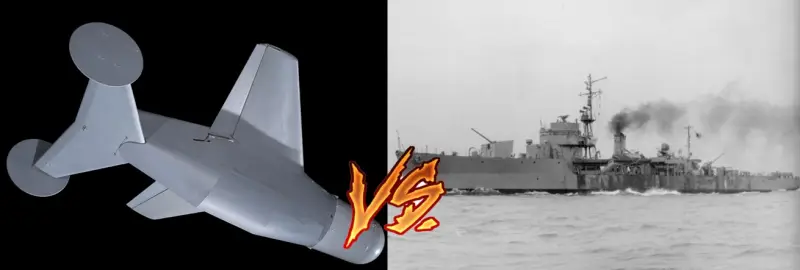
The main characters of the publication are the BAT glide bomb and the Ukuru-type kaibokan.
Kaibokan (Japanese: 海防艦 kaibokan, “coastal defense ship”) became real workhorses in the Imperial navy Japan. These ships accompanied convoys and hunted for submarines. They were closest in their functions and characteristics to such classes as frigate and destroyer escort in the fleets of their opponents in the Pacific theater of operations.
In total, more than 170 ships of this type, of all classes, entered service. Not as many as the same frigates and escort destroyers among the Allies, but still it was a more than massive type of ship.
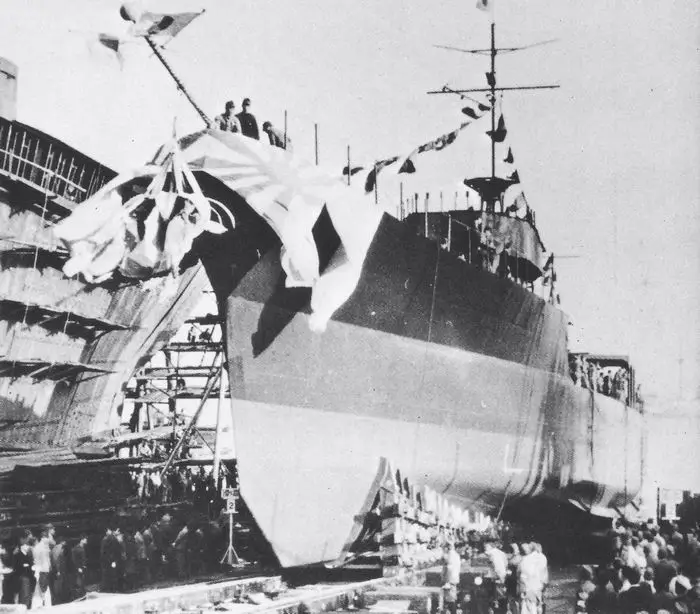
The ceremony of launching the main kaibokan of the series. Actually, “Ukuru” himself, May 15, 1944.
The ships' armament mainly consisted of 120 mm Type 3 guns, 25 mm Type 96 anti-aircraft guns and bomb releasers. Fighting off planes and hunting submarines are the main activities of these ships for most of their service. True, by 1945 the hunter himself had long ago turned into prey. For example, of the D-type kaibokans that died during the war, most were sunk by the army or navy. aviation...or submarines. Yes, the American submarine itself actively hunted its opponents, but this is a completely different matter. story.
Our hero is an Ukuru-class escort ship. Laid down at the Tsurumi shipyard in Yokohama on February 15, 1944, launched on September 21, 1944, and entered service in the Kure Naval District on December 2, 1944. The ship was named "Aguni" (an island in Okinawa Prefecture).
In January 1945, the ship was assigned to the First Division of Escort Forces and on January 21 arrived in Tokuyama to its place of permanent deployment. To put it very roughly, by the time the ship entered service, its further fate most likely represented a choice: a torpedo - one, or a bomb through the porthole.
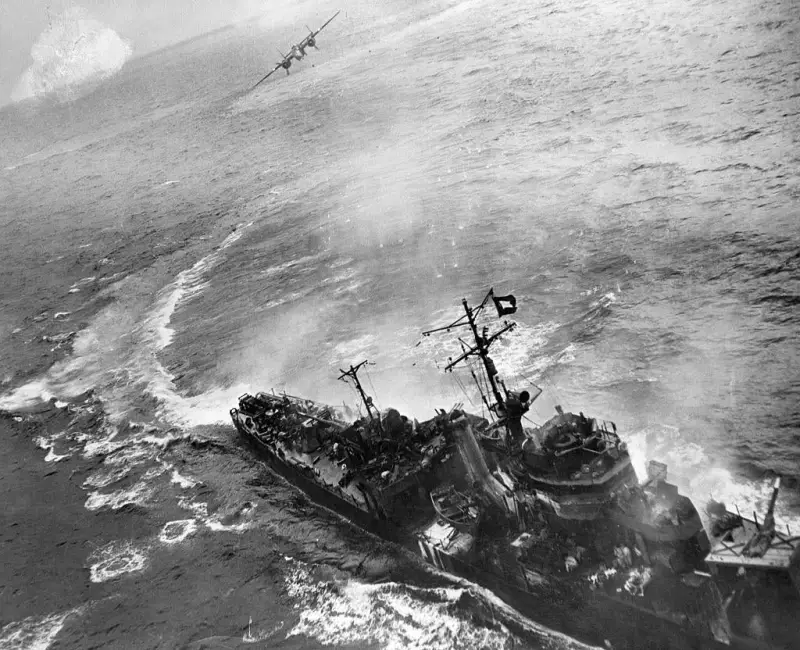
Kaibokan and top-mast bombing of Army North American B-25 Mitchells off the coast of Indochina, April 1945. It is clearly visible that there is no one at the anti-aircraft guns, and the sailors are lying side by side on the deck or hiding behind the superstructure. Before starting the actual bombing, the planes sprayed the ship with a 50-caliber machine gun from the bow battery. So, when the bombers actually made their bombing approach, there was often no one left on deck to man the anti-aircraft guns.
In general, this is how it all turned out.
Kamikaze dwarf
The fatal date was May 27, 1945. The ship was at sea off the coast of Korea. An airplane appeared on the horizon. The target was single and quite small in size. It seemed that the plane was coming in to attack the kaibokan, but did not start spraying the deck and superstructure from the battery with a machine gun; it was clearly (judging by its size) not a torpedo bomber, and there were no suspended bombs visible.
Meanwhile, the plane, heading straight for the ship, crashed into the side at the bow just above the waterline. Kaibokan was rocked by a terrible explosion. The bow of the ship up to the bow gun turret was torn off. A fifth of the crew (2 officers and 33 sailors) died.
The crew began to fight for survivability and, with the support of other ships of the convoy, were able to bring the ship to the port of Busan, and the kaibokan was sailing stern first. The ship was able to be dragged to a shipbuilding plant in the city of Maizuru. The damage was such that the repairs that had begun were not completed until the end of the war. The ship surrendered to the allies at the dock and was cut into metal there in 1948.
The surviving officers from the ship's crew, naturally, had to write reports and answer about the reasons for what happened to their superiors. And everyone said the same thing - we were attacked by a small plane... a kamikaze.
What happened in reality?
In fact, this was one of the most successful (if not the most successful) use by the Americans of the ASM-N-2 Bat gliding, homing, air-launched anti-ship bomb. Yes, there were other targets hit and ships sunk. But the kaibokan turned out to be the largest ship hit by the “bat”. The bomb was the crowning achievement of the program to develop a guided anti-ship weapon. weapons – SWOD (Special Weapons Ordnance). It had its own radar and was aimed at the target after launch independently. That is, “let it go and forget it,” and this was in the spring of 1945.
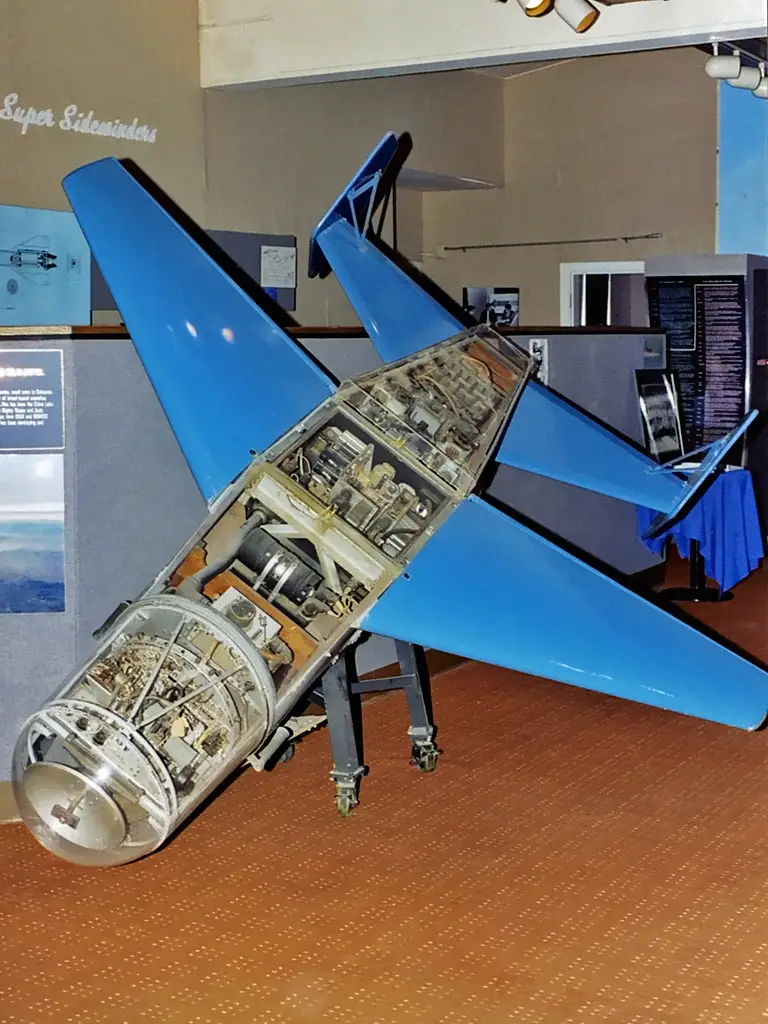
"Bat" in section. Probably the most technically complex ammunition used in World War II. Exhibit at the China Lake Museum, Ridgecrest, California.
The bomb was launched from the Consolidated PB4Y-2 Privateer maritime patrol bomber of the 109th Patrol Bombing Squadron (Patrol Bombing Squadron 109 - VPB-109). The unit was formed during the war, but by 1945 it already had extensive combat experience, had perfectly mastered the materiel, and was more than deserved.
Moreover, the crew of Lieutenant Commander George Hicks, who was responsible for making the Aguni officers believe in the existence of dwarf kamikaze pilots in the US Navy, already had experience using the latest ammunition. Hicks' crew attacked Japanese coasters twice in April 1945 in Balikpapan Bay.
True, the Americans themselves stated that they hit the destroyer. And although they did not see the sinking of the ship, the Japanese drove away a couple of patrol bombers with fire from 120-mm universal guns (Aguni was paired with another kaibokan), the ship was recorded as sunk. Why feel sorry for the enemy, especially on the pages of reports?
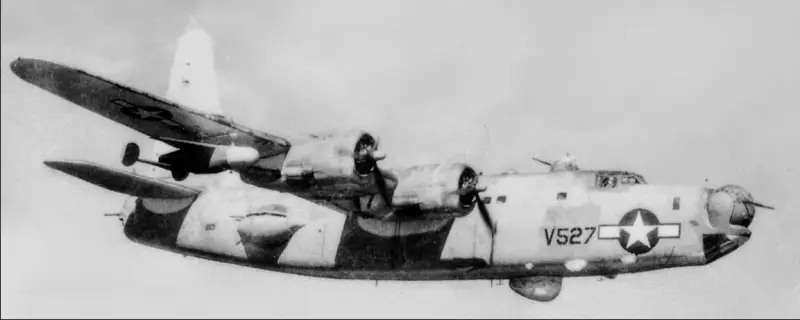
Consolidated PB4Y-2 Privateer from VPB-109 in flight with a pair of ASM-N-2 Bats under the wings.
It is clear that none of the kaibokan officers could even approximately imagine the technological level at which America was in 1945 and what a colossal gap actually existed between Japan and the United States. But it’s still funny that the first thing they thought of was that the Americans had found suicide dwarfs to put them in small bombs with wings and let them into Japanese ships.
On the other hand, it was hard to imagine that the enemy had created a bomb that aimed at the target independently, but everyone had already heard about kamikazes. Plus, it fit well into the framework of official Japanese propaganda with stories like - criminals and mentally ill people are forcibly sent to the Marine Corps.
In general, official propaganda, which sometimes created the image of a foolish enemy, played a cruel joke on the soldiers and officers of the warring army, dulling their vigilance regarding the danger posed by the enemy, and ultimately undermining faith in the official information coming from the authorities, but this is as usual , a completely different story.
Information